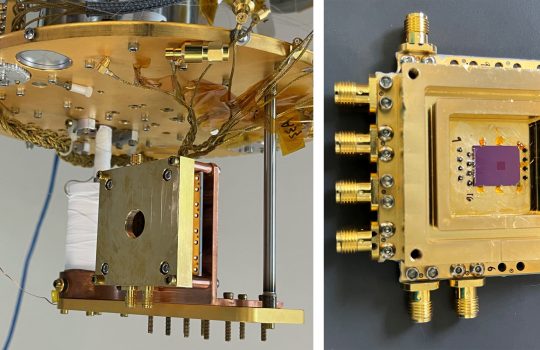In its ongoing quest to understand the nature of the universe’s fundamental constituents, the CMS collaboration has reached another milestone.
In October 2019, the U.S. contingent of the CMS collaboration presented their plans to upgrade the CMS particle detector for the high-luminosity phase of the Large Hadron Collider at CERN. The upgrades would enable CMS to handle the challenging environment brought on by the upcoming increase in the LHC’s particle collision rate, fully exploiting the discovery potential of the upgraded machine.
In response, on Dec. 19, 2019, the Department of Energy Office of Science gave the plan its stamp of CD-1 approval, signaling that it favorably evaluated the project’s conceptual design, schedule range and cost, among other factors.
“This is a major achievement because it paves the way for the next major steps in our project, in which funds are allocated to start the production phase,” said scientist Anadi Canepa, head of the Fermilab CMS Department. “The U.S. project team was extremely satisfied. Preparing for CD-1 was a monumental effort.”
The LHC’s increase in beam intensity is planned for 2027, when it will become the High-Luminosity LHC. Racing around its 17-mile circumference, the upgraded collider’s proton beams will smash together to reveal even more about the nature of the subatomic realm thanks to a 10-fold increase in collision rate compared to the LHC’s design value.
The cranked up intensity means that the High-Luminosity LHC will deliver an unprecedented amount of data, and the giant detectors that sit in the path of the beam have to be able to withstand the higher data delivery rate and radiation dose. In preparation, USCMS will upgrade the CMS detector to keep up with the increase in data output, not to mention to harsher collision environment.
The collaboration plans to upgrade the detector with state-of-the-art technology. The new detector will exhibit improved sensitivity, with over 2 billion sensor channels — up from 80 million. USCMS is also replacing the central part of the detector so that, when charged particles fly through it, the upgraded device will take readings of their momenta at an astounding 40 million times per second, a first for hadron colliders. They’re implementing an innovative design for the detector, measuring the energy of particles using very precise silicon sensors. The upgraded CMS will also have a breakthrough component to take higher-resolution, more precisely timed images of complex particle interactions. Scientists are introducing a system using machine learning on electronic circuits called FPGAs to more efficiently select which of the billions of particle events that CMS processes every 25 nanoseconds might signal new physics.
“The successful completion of the CD-1 review is a reflection of the competence, commitment and dedication of a very large team of Fermilab scientists and university colleagues,” said Fermilab scientist Steve Nahn, U.S. project manager for the CMS detector upgrade.
Now USCMS will refine the plan, getting it ready to serve as the project baseline.
“With these improvements, we’ll be able to explore uncharted territories and might discover new phenomena that revolutionize our description of nature,” Canepa said.
The USCMS collaboration comprises Fermilab and 54 institutions.
Fermilab is a DOE national laboratory funded by the Office of Science.




